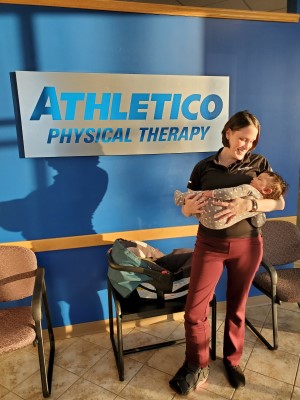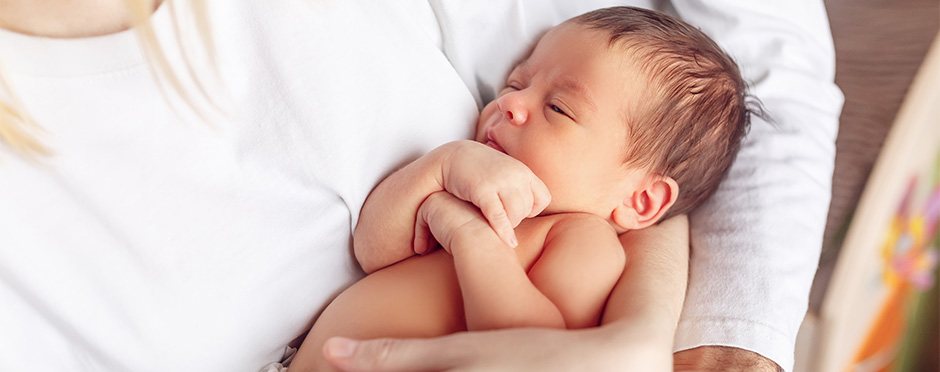
New Parent Posture Survival Guide
Leave a CommentYour beautiful bundle of joy has made their debut, and all you want to do is snuggle your precious little one, or your little seems always to want to be close to you. If this sounds like your situation, I can 100% relate because I have a five-month-old and a 2.5-year-old. I treat upper extremity injuries, and I never considered the importance of body mechanics when lifting and carrying my little ones until I started to experience the aches and pains of loving on my precious little ones at all hours of the day and night. Our little ones love us no matter the learning curve parenthood requires, and they need us at our healthiest. Let me share some tips I have learned.
Posture Tips for Nursing or Bottle-Feeding
To start, whether you are nursing or bottle-feeding, using a forearm hold with a neutral wrist is very important as it allows the flexor and extensor forearm muscles to work synergistically to stabilize your baby. Your wrist is in a neutral position when your thumb is in line with your forearm, and the wrist is bent slightly back. Letting your wrist extend or flex for long periods can cause a strain or imbalance in the forearm, leading to pain/discomfort.
This same type of wrist/forearm strain can happen when burping and picking up your child. The best way to minimize these injuries is to be aware of keeping your wrist neutral and stabilizing with your forearm while keeping your little one close to your core. When lifting your baby out of their car seat, one hand stabilizes behind the head/neck while the forearm braces baby’s upper back and the other hand stabilizes at the baby’s bottom as pictured. The other thing to note is squatting and lifting with your legs while engaging your core to stabilize your baby’s weight.
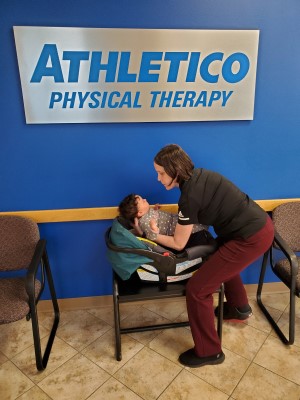
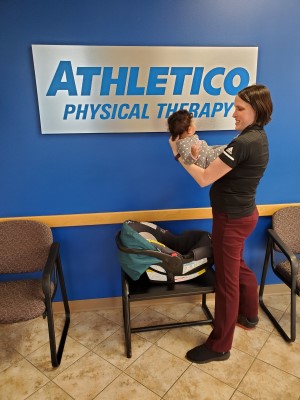
When burping your child or holding your child on your hip, allow your baby’s weight to rest on your forearm while your wrist relaxes in a neutral position, as pictured below.
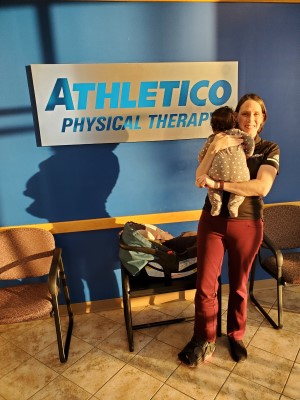
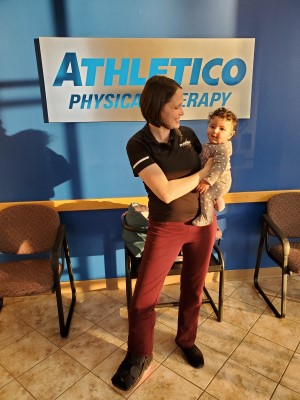
The Football Hold
If you have a little one with digestive issues, I have found the forward-facing football hold hugely helpful and comforting for my little one. According to research, side-lying helps with gastric emptying and motility.1 You are keeping the wrist in a neutral position, and holding your little one at your core balances the weight of your little one across your body.
- Begin with your baby lying on her back (swaddled if fussy).
- Gently roll them onto your forearm, cushioning their chest and stomach against your arm so that they are lying on her belly. Let their cheek rest on your palm or forearm. Their groin will be near your elbow while her legs will dangle, straddled over your arm.
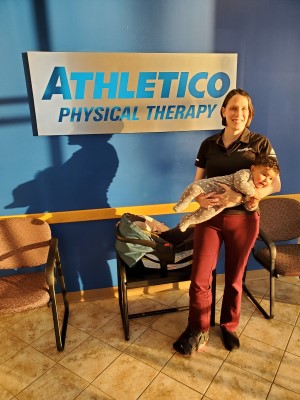
3 Forearm Stretches to Try if You’re in Pain
We cannot always be aware of our body mechanics, and if you start to notice a mild strain, here are a few forearm stretches to assist your body in finding balance/synergy again. I suggest starting with your elbow at your side and gradually stretching into full extension or to your tolerance – these should not be painful, so stretch within a pain-free range.
- Extend an arm in front of you with a straight elbow, palm down. Use the opposite hand to apply pressure to the top of the hand, downward toward the floor, holding 10 seconds.
- Then turn the palm up and apply pressure to the palm, bringing the hand towards the floor, hold for 10 seconds and repeat on the other arm. These will stretch the wrists and forearms.
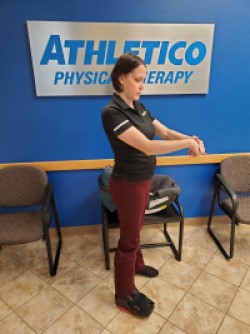
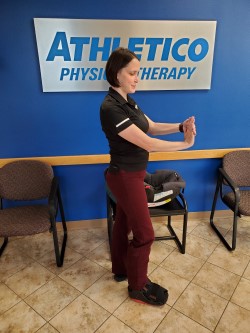
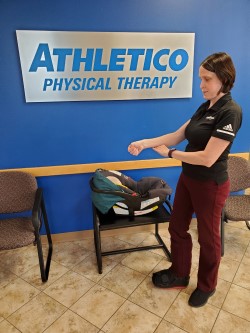
Exercises for the Core & Upper Body
As new parents, most of the snuggling of our little ones involves us being in a flexed posture. Engaging our extensor (back, arm, and leg muscles) is essential to offset the constant flexor engagement, allowing balance/synergy to resume. The superman pose is a great way to engage your core and the extensor mechanisms of the body. Regularly stretching your upper extremity/shoulder girdle prevents residual muscle tension from causing pain.
Superman pose
- Engage your back and abdominal muscles and slowly raise your arms, chest, and legs off the ground. Ensure your back, and abdominal muscles remain engaged throughout the exercise and avoid arching your back. Activation should be felt in the muscles along the length of your spine and not in the center of your back.
- Hold this position for 5-10 seconds and then return to start. Perform 2-8 repetitions.
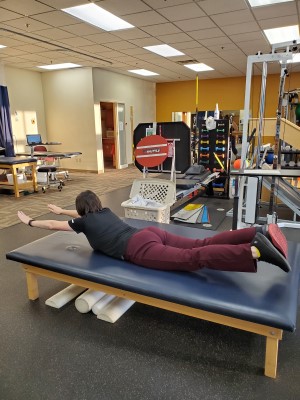
Doorway Stretches
Be sure to stretch in these three doorway stretches regularly for overall upper extremity health.
- Stand in a doorway, place hands on the door frame, take a short step forward, and keep your arms on the door until the stretch is felt across the chest and in front of the armpits.
- Hold for 30 seconds and perform three repetitions.
- Tip: Place hands at varying heights, as seen in the pictures below, to feel the stretch in different areas of the muscles.
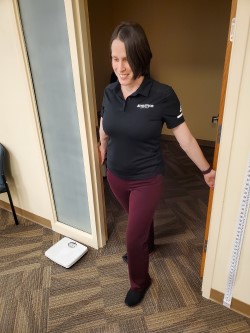
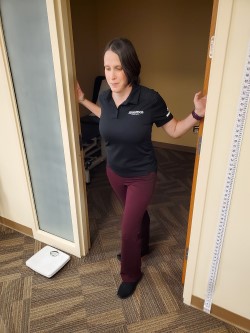
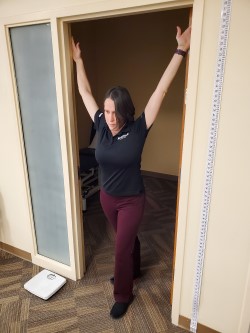
Parenting Hack: The Seat Belt Button
We’ve all experienced the torturous seat belt button on a child’s car seat, and I’m grateful it does such a great job of keeping my little ones safe. But my thumbs cry every time I release the safety seat belt of my child’s car seat. To save your thumbs and hands, grab a non-clickable pen with a wrist in neutral alignment and firmly press the end onto the red release button.
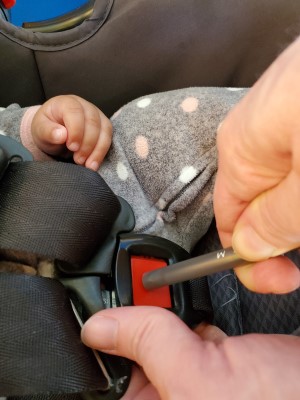
Posture Tips for the Car Seat Carrier
Holding the baby car seat carrier can be exhausting and cause nerve impingement at the elbow if the elbow hook is utilized too long. A great alternative is a midline/core stabilizing hold. It’s simple and has been a game-changer!
- Wrap your forearm through the handle grasping the handle joint with your hand – be sure your wrist is in neutral alignment.
- Allow the baby car seat carrier to rest at your side. This posture will enable you to maintain better spine alignment and upper extremity chain stability to prevent any long-term strain.
To balance your hip and shoulder health, I would also encourage you to alternate which side you hold your baby or baby car seat carrier. Not only does alternating sides help your health, but it is also helpful in reducing the likelihood of torticollis in your little ones as they naturally learn to stretch their neck muscles when they look to the person holding them.
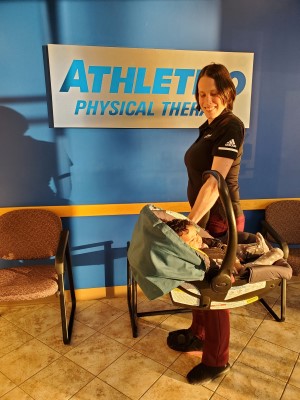
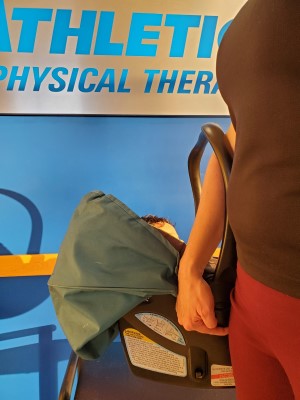
Reach Out to a Physical Therapist
If you have any questions or concerns about your body mechanics as you care for your beautiful, precious little ones, please reach out to an Athletico clinic near you for a Free Assessment! Learn how occupational and physical therapy can help get you feeling better so you can be your best self for your little ones today! Free Assessments are available in-clinic and virtually through our Telehealth platform.
*Per federal guidelines, beneficiaries of plans such as Medicare, Medicaid, Tricare, VHA and other federally funded plans are not eligible for free assessments.
The Athletico blog is an educational resource written by Athletico employees. Athletico bloggers are licensed professionals who abide by the code of ethics outlined by their respective professional associations. The content published in blog posts represents the opinion of the individual author based on their expertise and experience. The content provided in this blog is for informational purposes only, does not constitute medical advice and should not be relied on for making personal health decisions.
If you have questions about the development of your child, reach out to a Pediatric physical therapist near you.
References:
1. HE;, Elser. “Positioning after Feedings: What Is the Evidence to Reduce Feeding Intolerances?” Advances in Neonatal Cre : Official Journal of the National Association of Neonatal Nurses, U.S. National Library of Medicine, https://pubmed.ncbi.nlm.nih.gov/22668689/.
